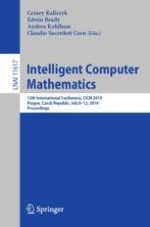This book constitutes the refereed proceedings of the 12th International Conference on Intelligent Computer Mathematics, CICM 2019, held in Prague, Czech Republic, in July 2019. The 19 full papers presented were carefully reviewed and selected from a total of 41 submissions. The papers focus on digital and computational solutions which are becoming the prevalent means for the generation, communication, processing, storage and curation of mathematical information. Separate communities have developed to investigate and build computer based systems for computer algebra, automated deduction, and mathematical publishing as well as novel user interfaces. While all of these systems excel in their own right, their integration can lead to synergies offering significant added value.

 on the one hand and formal, content-oriented ones such as proof assistants and computer algebra systems on the other hand have so far been developed and used largely independently. The former excel at communicating mathematical knowledge and the latter at certifying its correctness.
on the one hand and formal, content-oriented ones such as proof assistants and computer algebra systems on the other hand have so far been developed and used largely independently. The former excel at communicating mathematical knowledge and the latter at certifying its correctness. for the narrative and
for the narrative and  documents or written in the
documents or written in the
 document directly. In the latter case,
document directly. In the latter case,  compilation and substitutes it with
compilation and substitutes it with
 presentation macros.
presentation macros. than could easily be produced by hand, e.g., by inserting hyperlinks and tooltips into formulas. Moreover, it allows reusing formalizations across narrative documents as well as between formal and narrative ones. As a case study, the present document was already written with MMTTeX.
than could easily be produced by hand, e.g., by inserting hyperlinks and tooltips into formulas. Moreover, it allows reusing formalizations across narrative documents as well as between formal and narrative ones. As a case study, the present document was already written with MMTTeX.